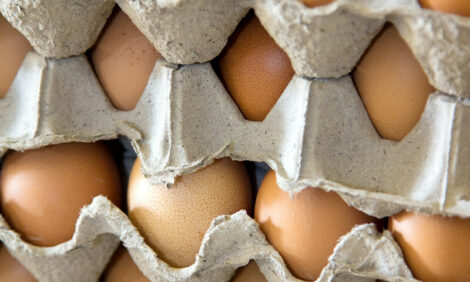



New Chicken Breed Changes Egg Industry Dynamics in India
INDIA - Seven years of research have paid rich dividends in the form of a unique breed of broiler chicken that can multiply three times as fast as ordinary hens, lay more eggs, and can survive in the open without any extra care, writes A Nair.The breed is the Jharsim chicken, a crossbred between the local and broiler variety, further crossed with imported Durham Red breed.
Developed by the Birsa Agricultural University at Ranchi, Jharkhand, the bird actually performs better on a low level of nutrition.
Scientists at the University claim the new breed of chicken called Jharsim - named so since it was developed in Jharkhand state and sim meaning hen in tribal dialect - is set to produce more eggs than the normal local hen, in a move that will enhance the economic power of poultry among farmers.
To develop the Jharsim breed, a PV2 male broiler from the state of Punjab was crossbred with a Jharkhand local hen. The hen produced by their mating was later bred with an imported Durham Red breed, imported by India for its bigger size and tender meat.
For experimental purposes, the University distributed 25,000 chicks from its first lot to villagers across Jharkhand state. More than 95 per cent of the chicks survived with most reproducing.
A handiwork of the All India Co-Ordinated Research Project on Poultry Breeding, the indigenous chicken boasts of faster growth, optimum egg production, an attractive multi-colour plumage, and better adaptability to agro-climatic conditions.
Scientists pointed out the birds weigh 400-500 grams at 6 weeks and 1600-1800 grams at maturity under the backyard system. The age at first egg laying is 175-180 days and the egg weight is 52-55 grams at 40 weeks of age.
The birds have the potential to lay 165-170 eggs under the backyard system. The variety is set to provide higher supplementary income and nutrition through both egg and meat to rural and tribal farmers.
While the local hen variety lays around 50-60 eggs in 54 weeks, each Jharsim hen can lay between 130-170 eggs in 72 weeks, according to H. Rahman, Deputy Director General (Animal Science), Indian Council of Agricultural Research.
Pointing out that poultry is the fastest growing sector in India, given that it provides jobs to an increasing number of rural and urban youth, Mr. Rahman said the development of the new, improved breed would give a big boost to poultry farming.
He pointed out that the Indian Council of Agricultural Research has been promoting intensive schemes in five states across India - Himachal Pradesh, Madhya Pradesh, Assam, Maharashtra and Jharkhand.
At many of these centres, intensive research is being carried out in the development of chicken varieties utilising local germplasm, and aimed at catering to the rising economy of rural marginal farmers through the rearing of these chicken varieties.
Noting that China was the global topper in poultry, contributing around 30 per cent of the world's production of meat and eggs, R.N. Chatterjee, Director, Directorate of Poultry Research, Hyderabad, said India lagged far behind, contributing barely 5 per cent-7 per cent.
"Jharsim can help boost production of meat and eggs in a big way," said Mr. Chatterjee, adding it provided immense potential for backyard poultry farming in Jharkhand's rural areas.
Jharsim has also been termed as more resistant to diseases, and can survive in natural habitat without much care. Shushil Prasad of the Birsa Agricultural University added that since Jharsim has traits of local chicken as well as traits of an exotic variety, it grows up to be bigger and develops a stronger immune system.







